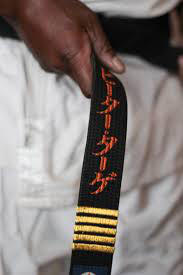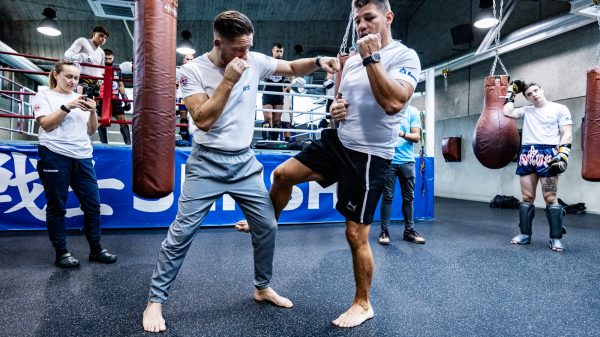In the martial disciplines we all tie belts around our waists, but few of us understand what they represent.
The meaning of our belts and the grading system they represent seems to have been lost. Some think they indicate skill level or expertise. Others think they are misleading, at best, only imported figments of oriental culture, or at worst, inflated symbols of ego. So what do they represent? Are they worthless, or are they meaningful symbols charged with the energy of years of dedication and hard work?
One of the biggest misconceptions held by new students, as well as the public, is thatobtaining a black belt represents being an expert. Nothing could be further from the truth. While training at the brown belt level is very demanding and the attainment of a black belt is seen as significant, black belt status really only indicates a graduation to a new beginning.
For this reason first level black belts are known as shodans, rather than ichi (first) dans, “sho” meaning beginning, the same character as in sho shin, meaning beginner’s mind. Reaching this first, beginning rank means you have achieved some proficiency in basics and are prepared to really start learning, and learning means a lot more than techniques. Thus a new shodan becomes a beginner again.
Actually the use of ranks and belts is a fairly new phenomenon. They weren’t used during the feudal period when warriors studied various fighting methods for battlefield purposes, nor were they used in Okinawa as karate was developing. The kyu/dan system associated with colored belts is really a late 19th century invention pioneered by Jigoro Kano, the father of judo. He created the kyu/dan system in 1883 and awarded his two top students with a dan (rank) rating. Three years later he began to award black sashes to be worn with a practice top kimono or Japanese robe. Pants were then not in use, instead many wore loin cloths, or more commonly shorts cut off above the knee. Kano’s organization, the Kodokan, later adopted the full uniform with pants (keikogi) we know today. In approximately 1907 the sash was replaced by the kuri obi (black belt).
Kano saw the need to distinguish between beginning and advanced students. Beginners wore white belts and were considered unranked, but within this classification there were different levels known as kyu. New students started at the highest kyu (usually ten), the level decreasing with experience to first kyu, the last level before promotion to dan, the rank level symbolized by the black belt. Sometimes first or second kyus wore brown belts signifying that they were completing their basics and soon would become ranked. It was understood that kyu levels were only an introduction to more advanced training on a dan level. Over time various system have adopted six to ten kyu levels for their promotion curriculum and dan steps progressing upwards from first dan. In many budo arts dan status was achieved quite easily once serious studies began. In other systems, however, attaining a dan ranking was stretched out taking five to seven years of serious study, or more. Because beginners were unranked they were known as mudansha, “mu” being a Zen term meaning nothingness, an expression of negation. “Dan” is rank and “sha” is a person. Advanced students, ones who had mastered basics (awarded a dan rank) are called yudansha, “yu,” meaning possession. Thus the term means, “A person in possession of rank.”
The contrasting color of black (ranked) and white (unranked, colored kyu were not then in use) belts are laden with deeper symbolism. They reflect a yin, yang nature (in Japan in/yo) reflecting budo’s roots in Taoist tradition represented by the term “do,” or path, and represent the basic polarity of opposites. This concept of dualism was also expressed in the Chi Hsi school of Confucism (that had an important impact on budo’s formation) with its concept of form (or yukei, representing rank in budo) and non-form (mukei, representing non-rank). The white belt, along with the white uniform, also reflect budo values – purity, avoidance of ego and simplicity. There is also no visual, or outward indication of class or level of expertise. Thus everyone begins as an equal (without class) – a former noble could be standing next to a farmer. This was significant because earlier times (pre-1868) were characterized by a rigid class structure, within which classes were strictly separated and most were prohibited from martial study.
The kyu/dan system and associated belts was given a big boost by Japan’s first martial arts association formed to promote the revival of the martial teaching tradition in the modern era. In 1895 the government had sanctioned the formation of the Dai Nippon Butokukai (Japan Great Martial Virtues Association) to oversee, standardize and promote the various martial traditions (ryuha). A committee was commissioned (adopting kano’s innovations) to grant budo/bujitsu martial rank certification (budo/bujitsu menjo) based on the kyu/dan system and to grant teaching licenses (Shihan menjo).
Under butokukai leadership budo and bujitsu became revolutionized in Japan. A common system of uniforms, ranking, belts and promotion was adopted. Even practice methods became somewhat standardized. The Butokukai also promoted the adoption of budo training (including judo, kendo, kyudo and naginata-do) within the general education system and the teaching of bushido (the warriors code of ethics). Judo and kendo were promoted as sports.
The kyu/dan system was never designed merely to indicate a level of technical achievement. It also represents budo’s goal of spiritual and ethical attainment towards perfection of the self. Thus dan rankings, and even kyu levels, should reflect a level of moral and spiritual development or attainment. For this reason children have always been classified differently with their own kyu and dan status and with their own distinct belts, the black belt often having a white stripe down the middle. This is because children are judged to be not fully mature and too young to have developed those aspects of character that budo represents. For this reason many schools retest their students at an age of 14 or 15 to qualify them for adult standing. Thus the kyu/dan system reflects evaluation of a person’s spiritual progress towards perfection (attainment of discipline, values, ethics, manners, deportment, etc.) within a martial discipline.
In the early 20th century karate had just been introduced into Japan from Okinawa where it had been practiced in secrecy for centuries. In Suri, Okinawa’s capital, karate been introduced publicly as part of the physical education curriculum of the middle school starting around 1905. But there was no ranking, belts or uniforms at that time. The kyu/dan ranking and belt/uniform system was first adopted by karate in Japan (the first dans awarded by Gichin Funakoshi to seven students in 1924) as a means of gaining acceptance by the Butokukai. Okinawa karate later followed the Japanese karate lead.
Only within the last 30 years have some martial disciplines or organizations begun to use colored belts to signify different levels of kyu. This was done to give students a sense of accomplishment. They were adopted in response to the desire voiced by many, mostly foreign students in Japan and students abroad, who sought some outward manifestation of their progress. There is no agreement, however, on color, or order of color, except that in many systems a brown belt precedes attainment of a back belt (dan status).
As to ranking of black belts, technically there are 10 progressive dan levels, first through tenth, but realistically, promotion within each system is limited to a level below that of the system’s founder, chief instructor or inheritor. Thus within Shotokan karate, whose founder, Gichen Funikoshi, was ranked as a fifth dan (godan), no one within the system had an equal or higher rank until his death.
All dan levels wear blacks, except for various combinations of red, white and black used on ceremonial occasions usually for fifth degree black belt and above. Some systems now signify dan ranking by stripes on one belt tip, the number of stripes indicating the grade. Some systems, however, symbolize various teaching titles with black belt stripes. But achieving a dan level today in Japan is not restricted merely to the marital arts. Dan ranking has been extended to a wide variety of activities. There are even dans awarded for skill in sake (rice wine) tasting.



































